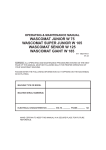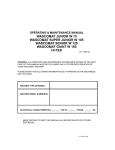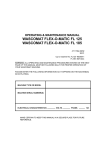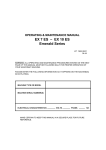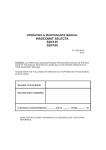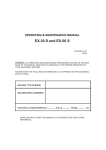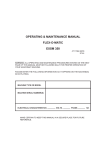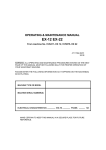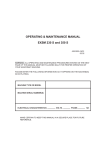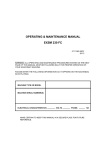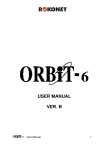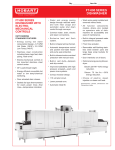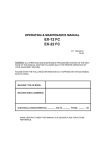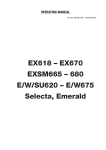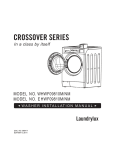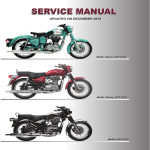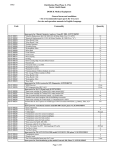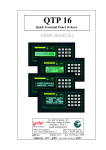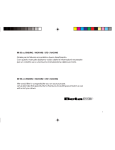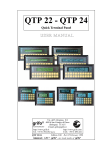Download Wascom W185ES Operating instructions
Transcript
OPERATING & MAINTENANCE MANUAL WASCOMAT JUNIOR W 75 WASCOMAT SUPER JUNIOR W 105 WASCOMAT SENIOR W 125 WASCOMAT GIANT W 185 471 1562-75/04 00.23 WARNING: ALL OPERATING AND MAINTENANCE PROCEDURES SHOWN ON THE NEXT PAGE OF THIS MANUAL MUST BE FOLLOWED DAILY FOR PROPER OPERATION OF YOUR WASCOMAT MACHINE. PLEASE ENTER THE FOLLOWING INFORMATION AS IT APPEARS ON THE MACHINE(S) DATA PLATE(S). MACHINE TYPE OR MODEL MACHINE SERIAL NUMBER(S) ELECTRICAL CHARACTERISTICS: ________ VOLTS, _______ PHASE, _______ HZ. MAKE CERTAIN TO KEEP THIS MANUAL IN A SECURE PLACE FOR FUTURE REFERENCE. OPERATING & MAINTENANCE MANUAL WASCOMAT JUNIOR W 75 WASCOMAT SUPER JUNIOR W 105 WASCOMAT SENIOR W 125 WASCOMAT GIANT W 185 WARNING: ALL OPERATING AND MAINTENANCE PROCEDURES SHOWN ON THE NEXT PAGE OF THIS MANUAL MUST BE FOLLOWED DAILY FOR PROPER OPERATION OF YOUR WASCOMAT MACHINE. PLEASE ENTER THE FOLLOWING INFORMATION AS IT APPEARS ON THE MACHINE(S) DATA PLATE(S). MACHINE TYPE OR MODEL MACHINE SERIAL NUMBER(S) ELECTRICAL CHARACTERISTICS: ________ VOLTS, _______ PHASE, _______ HZ. MAKE CERTAIN TO KEEP THIS MANUAL IN A SECURE PLACE FOR FUTURE REFERENCE. II NOTICE TO: OWNERS, OPERATORS AND DEALERS OF WASCOMAT MACHINES IMPROPER INSTALLATION AND INADEQUATE MAINTENANCE, POOR HOUSEKEEPING AND WILLFUL NEGLECT OR BYPASSING OF SAFETY DEVICES MAY RESULT IN SERIOUS ACCIDENTS OR INJURY. TO ASSURE THE SAFETY OF CUSTOMERS AND/OR OPERATORS OF YOUR MACHINE, THE FOLLOWING MAINTENANCE CHECKS MUST BE PERFORMED ON A DAILY BASIS. NOTICE À L’ATTENTION DES PROPRIÉTAIRES, UTILISATEURS ET REVENDEURS DE MACHINES WASCOMAT UNE INSTALLATION INCORRECTE ET UN ENTRETIEN INADÉQUAT, DE MÊME QUE LA NÉGLIGENCE OU LA NEUTRALISATION DÉLIBÉRÉES DES DISPOSITIFS DE SÉCURITÉ, PEUVENT ÊTRE CAUSES DE BLESSURES OU D’ACCIDENTS SÉRIEUX. POUR ASSURER LA SÉCURITÉ DES CLIENTS ET/OU DES UTILISATEURS DE VOTRE MACHINE, IL EST INDISPENSABLE DE PROCÉDER CHAQUE JOUR AUX CONTRÔLES DE ROUTINE CI-APRÈS. 1. Prior to operation of the machine, check to make certain that all operating instructions and warning signs are affixed to the machine and legible. (See the following page of this manual for description and location of the signs.) Missing or illegible ones must be replaced immediately. Be sure you have spare signs and labels available at all times. These can be obtained from your dealer or Wascomat. 2. Check the door safety interlock, as follows: (a) OPEN THE DOOR of the machine and attempt to start in the normal manner: For coin-operated models, insert the proper coins to start the machine. For manually operated models, place the ON-OFF switch in the ON position and press the Start switch. THE MACHINE(S) MUST NOT START ! (b) CLOSE THE DOOR to start machine operation and, while it is operating, attempt to open the door without exerting extreme force on the door handle. The door should remain locked! If the machine can start with the door open, or can continue to operate with the door unlocked, the door interlock is no longer operating properly. The machine must be placed out of order and the interlock immediately replaced. (See the door interlock section of the manual.) 3. DO NOT UNDER ANY CIRCUMSTANCES ATTEMPT TO BYPASS OR REWIRE ANY OF THE MACHINE SAFETY DEVICES AS THIS CAN RESULT IN SERIOUS ACCIDENTS. 4. Be sure to keep the machine(s) in proper working order: Follow all maintenance and safety procedures. Further information regarding machine safety, service and parts can be obtained from your dealer or from Wascomat through its Teletech Service Hotline - 516/3710700. All requests for assistance must include the model, serial number and electrical characteristics as they appear on the machine identification plate. Insert this information in the space provided on the previous page of this manual. 5. WARNING: DO NOT OPERATE MACHINE(S) WITH SAFETY DEVICES BYPASSED, REWIRED OR INOPERATIVE! DO NOT OPEN MACHINE DOOR UNTIL DRUM HAS STOPPED ROTATING! AVERTISSEMENT: NE PAS FAIRE FONCTIONNER LA (LES) MACHINE(S) AVEC UN DISPOSITIF DE SÉCURITÉ NEUTRALISÉ, RECÂBLÉ OU NON OPÉRATIONNEL! NE PAS OUVRIR LA MACHINE TANT QUE LE TAMBOUR NE S’EST PAS IMMOBILISÉ! SAFETY AND WARNINGS SIGNS Replace If Missing Or Illegible One or more of these signs must be affixed on each machine as indicated, when not included as part of the front instruction panel. LOCATED ON THE OPERATING INSTRUCTION SIGN OF THE MACHINE: CAUTION PRECAUCION 1. Do not open washer door until cycle is completed, operating light is off, and wash cylinder has stopped rotating. 1. No abra la puerta de la máquina lavadora sino hasta que la máquina haya terminado su ciclo, la luz operativa esté apaga da y el cilindro de lavado haya completamento terminado de girar. 2. Do not tamper with the door safety switch or door lock. 3. Do not attempt to open door or place hands into washer to remove or add clothes during operation. This can cause serious injury. MACHINE SHOULD NOT BE USED BY CHILDREN 2. No interferia o manipule el switch o la cerradura de la puerta. 3. No trate de abrir la puerta o meta las manos dentro de la máquina para meter o sacar ropa mientras la máquina está en operación, pues puede resultar seriamento herido. LAS MÁQUINAS NO DEBEN SER USADAS POR NIÑOS LOCATED AT THE REAR OF THE MACHINE: INSTALLATION AND MAINTENANCE WARNINGS 1. This machine MUST be securely bolted according to the installation instruction to reduce the risk of fire and to prevent serious injury, or damage to the machine. Pour reduire les risques d'incendie, fixer cet appareil sur un plancher beton sans revetement. 2. If installed on a floor of combustible material, the floor area below this machine must be covered by a metal sheet extending to the outer edges of the machine. 3. This machine MUST be connected to a dedicated electrical circuit to which no other lightning unit or general purpose receptacle is connected. Use copper conductor only. Utiliser seulement des conducteurs en cuivre. 4. This machine MUST be serviced and operated in compliance with manufacturer's instructions. CHECK DOOR LOCKS EVERY DAY FOR PROPER OPERATION TO PREVENT INJURY OR DAMAGE. IF THE DOOR LOCK FAILS TO OPERATE PROPERLY, PLACE THE MACHINE OUT OF ORDER UNTIL THE PROBLEM IS CORRECTED. 5. Disconnect power prior to servicing of machine. Deconnecter cet appareil del'alimentation avant de proceder a l'entretien. 6. To remove top panel, first remove screws at the rear. When remounting the top, reinstall them. To remove the top panel on models on which it is secured by one or two keylocks, use the keys originally shipped in the drum package. Be certain to relock after remounting the top panel. MANUFACTURED BY WASCATOR DISTRIBUTED BY WASCOMAT INWOOD, NEW YORK, USA LOCATED ON THE DOOR: If you need to order more safety or warning signs, call Wascomat's parts department at 516-371-2000, or call your local dealer. 471 7662-02 WARNING ! DO NOT ATTEMPT TO OPEN DOOR UNTIL PROGRAM HAS FINISHED AND DRUM HAS STOPPED ROTATING. 471 7661-17 Wascomat Junior W 75 • Wascomat Super Junior W 105 Wascomat Senior W 125 • Wascomat Giant W 185 Contents Introduction ...................................................................... 1 Technical data .................................................................. 2 Installation ........................................................................ 7 Safety rules .................................................................... 14 Operating instructions .................................................... 15 Wash programs .............................................................. 16 Mechanical and electrical design ................................... 22 Maintenance ................................................................... 40 Trouble-shooting ............................................................ 41 The manufacturer reservs the right to make changes to design and material specifications. Safety instructions • The machine is designed for water washing only. • The machine must not be used by children. • All installation operations are to be carried out by qualified personnel. Licensed personnel are necessary for all electric power wiring. • The interlock of the door must be checked daily for proper operation and must not be bypased. • All seepage in the system, due to faulty gaskets etc., must be repaired immediately. • All service personnel must be fully familiar with the operating manual before attempting any repair or maintenance of the machine. • The machine must not be sprayed with water, otherwise short circuiting may occur. • Fabric softeners with volatile or inflammable fluids are not to be used in the machine. Consignes de sécurité • La machine est conçue pour le lavage à l’eau exclusivement. • La machine ne peut être utilisée par des enfants. • Tous les travaux d’installation doivent être effectués par une personne qualifiée. Tous les câblages électriques doivent être réalisés par un électricien diplômé. • Le verrouillage du hublot doit être vérifié chaque jour et ne peut être neutralisé. • Toute fuite du système, due à des joints défectueux etc., doit être réparée sans délai. • Tous les membres du personnel d’entretien doivent être parfaitement familiarisés avec le manuel d’entretien avant d’entreprendre une réparation ou un entretien de la machine. • Ne jamais asperger d’eau la machine sous peine de risquer un court-circuit. • Ne pas utiliser dans la machine des adoucissants textiles contenant des liquides volatils ou inflammables. 23 Introduction 1 Introduction The Wascomat Junior, Super Junior, Senior and Giant models washer/ extractors have been developed to cover the heavy duty and various size requirements of coin laundries, apartment houses, hotels, motels, nursing homes, hospitals, professional laundries, restaurants, schools, colleges and all on-premises laundries where high quality automatic washing and quick formula variation are required. Fig. 1 The W models offer four pre-set wash programs Hot, Warm, Cold and Delicate which can be selected by turning the rotary program selector on the front panel. These programs are designed to suit a variety of fabrics and offer different water temperature programs. The machine is designed for connection to hot and cold water supplies. All parts of the machine which come into contact with the items being washed are made of heavy gauge surgical stainless steel, ensuring long life and lasting beauty, as well as full protection for no-iron fabrics. All electrical components are made accessible for servicing by simply removing the top panel. This manual contains a technical description of the Wascomat W75, W105, W125 and W185 model machines and instructions for their installation, operation and maintenance. Together with the wiring diagram which accompanies each individual machine it should be kept in a safe place for easy reference. When ordering spare parts always give the machine serial number, model, voltage and other electrical characteristics appearing on the nameplate at the rear of the machine. 1 1193 Technical data 2 Technical data Wascomat Junior W75 Dry load capacity up to 7.5 kg 18 lbs Overall dimensions Width 660 mm 26 in Depth (at the top) 593 mm 23 3/8 in Height 1050 mm 41 5/16 in Diameter 520 mm 20 1/2 in Depth 356 mm 14 in Volume 75 litre 2.7 cu.ft Inner drum Speed of rotation G-factor Floor loading Motor speed Rated output power Wash 54 r.p.m. Extraction 543 r.p.m. During wash 0.8 During extraction 90 Net weight 107 kg 235 lbs Dyn force 1.2±2.6 kN 290±620 lbs. force During wash 360 r.p.m. During extraction 3380 r.p.m. Motor, wash, 3-phase 110 W 0.15 HP Motor, extract., 3-phase 550 W 0.75 HP Motor, wash, 1-phase 110 W 0.15 HP Motor, extract., 1-phase 370 W 0.5 HP Voltage requirements Choice: 120 V 1-phase 60 Hz or 208-240 V 3-Phase 60 Hz Overcurrent protection Three-phase 15 A Single-phase 20 A Water connections Recommended water pressure 2-6 kp/cm2 25-85 psi Hose connection, water 20 DN 3/4 in Hose connection, drain 74 mm 3 in Technical data 3 Technical data Wascomat Super Junior W105 Dry load capacity up to 11.5 kg 25 lbs Overall dimensions Width 660 mm 26 in Depth (at the top) 710 mm 27 5/16 in Height 1135 mm 44 11/16 in Diameter 520 mm 20 1/2 in Depth 473 mm 18 5/8 in Volume 100 litre 3.6 cu.ft Inner drum Speed of rotation G-factor Floor load Motor speed Rated output power Wash 54 r.p.m. Extraction 543 r.p.m. During wash 0.8 During extraction 90 Net weight 161 kg 355 lbs Dyn force 1.7 ±3.4 kN 408±816 lbs. force During wash 360 r.p.m. During extraction 3450 r.p.m. Motor, wash 3-phase 150 W 0.2 HP Motor, extract. 3-phase 900 W 1.2 HP Motor, wash 1-phase 140 W 0.18 HP Motor, extract. 1-phase 550 W 0.75 HP Voltage requirements Choice: 120 V 1-phase 60 Hz or 208-240 V 3-Phase 60 Hz Overcurrent protection Three-phase 15 A Single-phase 20 A Water connections Recommended water pressure 2-6 kp/cm2 25-85 psi Hose connection, water 20 DN 3/4" Hose connection, drain 74 mm 3" Technical data 4 Technical data Wascomat Senior W125 Dry load capacity up to 16 kg 35 lbs Overall dimensions Width 745 mm 29 5/16 in Depth (at the top) 915 mm 36 in Height 1196 mm 47 1/16 in Diameter 620 mm 24 1/2 in Depth 520 mm 20 1/2 in Volume 157 litre 5.65 cu.ft Inner drum Speed of rotation G-factor Floor load Motor speed Rated output power Wash 52 r.p.m. Extraction 500 r.p.m. During wash 0.9 During extraction 87 Net weight 210 kg 462 lbs Dyn force 2.4±4.8 kN 576±1152 lbs. force During wash 360 r.p.m During extraction 3450 r.p.m Motor, wash 3-phase 300 W 0.4 HP Motor, extract. 3-phase 1300 W 1.8 HP Motor, wash 1-phase 280 W 0.4 HP Motor, extract. 1-phase 1300 W 1,8 HP Voltage requirements Choice: 208-240 V 1-phase 60 Hz or 208-240 V 3-Phase 60 Hz Overcurrent protection Three-phase 15 A Single-phase 20 A Water connections Recommended water pressure 2-6 kp/cm2 25-85 psi Hose connection, water 20 DN 3/4" Hose connection, drain 74 mm 3" Technical data 5 Technical data Wascomat Giant W 185 Dry load capacity up to 23 kg 50 lbs Overall dimensions Width 827 mm 32 9/16 in Depth (at the top) 960 mm 37 13/16 in Height 1315 mm 51 3/4 in Diameter 700 mm 27 9/16 in Depth 600 mm 23 5/8 in Volume 230 litre 8.1 cu.ft Inner drum Speed of rotation G-factor Floor load Motor speed Rated output power Wash 45 r.p.m. Extraction 455 r.p.m. During wash 0.8 During extraction 81 Net weight 264 kg 582 lbs Dyn force 3.1±5.2 kN 744±1248 lbs. force During wash 360 r.p.m During extraction 3480 r.p.m Motor, wash 3-phase 400 W 0.55 HP Motor, extract. 3-phase 2000 W 2.7 HP Motor, wash 1-phase 400 W 0.55 HP Motor, extract. 1-phase 1800 W 2.4 HP Voltage requirements Choice: 208-240 V 1-phase 60 Hz or 208-240 V 3-Phase 60 Hz Overcurrent protection Three-phase 15 A Single-phase 20 A Water connections Recommended water pressure 2-6 kp/cm2 25-85 psi Hose connection, water 20 DN 3/4" Hose connection, drain 74 mm 3" Technical data 6 Outline and dimensions C Electrical cable connection D 2 3 1 L M N A J E K B F G 3210 A 4 1 2 3 4 W75 W105 Cold water Hot water Hot water (W185) Drain outlet W125 W185 mm inches mm inches mm inches mm inches A 1050 41 5/16 1135 44 11/16 1196 47 1/16 1315 51 3/4 B C D E F G H J K L M N 437 660 593 895 100 125 980 – 890 – 205 160 17 3/16 26 23 3/8 35 1/4 3 15/16 4 15/16 38 9/16 – 35 – 8 1/6 6 5/16 522 660 710 980 185 125 1065 – 975 – 205 160 20 9/16 26 27 15/16 38 9/16 7 5/16 4 15/16 41 15/16 – 38 3/8 – 8 1/16 6 5/16 465 745 915 1040 100 270 1130 – 1035 – 205 160 18 5/16 29 5/16 36 40 15/16 3 15/16 10 5/8 44 11/16 – 40 3/4 – 8 1/16 6 5/16 540 827 960 1160 100 260 1255 1215 1155 295 205 160 21 1/4 32 9/16 37 13/16 45 11/16 3 15/16 10 1/4 49 7/16 47 13/16 45 1/2 11 5/8 8 1/16 6 5/16 H Installation Installation 7 2 Machine foundation Fig. 2 Fig. 3 Fig. 4 The machines are designed to be bolted in position to a concrete floor or specially prepared concrete foundation. A template showing the size of the foundation and positioning of the foundation bolts can be provided by Wascomat. For installation on an existing concrete floor, the floor must be at least 8" thick and of good quality. If the floor does not meet these requirements, then a 6-8" high concrete foundation should be made. A prefabricated steel base is available for mounting of machines without an additional foundation. Follow the instructions below when making a concrete foundation: 1. Decide where to place the machine and consider maintenance requirements, i.e. determine a suitable distance from the rear of the foundation to the wall, and the distance from the foundation to the nearest side wall. The distance should be at least 16 and 12 inches, respectively. 2. Break up the floor to a depth of 3 inches, making sure that the sides of the hole slope inwards - the bottom of the hole should be 5 inches longer than the upper length. 3. Wet the hole well. Brush the bottom and sides with cement grout. 4. Prepare a casing and fill with 3,000 PSI min. concrete to form a pad. Make sure the foundation is level. 5. Use the template to position the foundation bolts correctly - bolts are to extend 1 1/2" above concrete. NOTE: A prefabricated steel frame, designed to be placed in the concrete instead of the individual mounting bolts, is available from Wascomat. W75 mm W105 inches mm W125 inches mm 0271 3 1677 4 K E W185 inches mm inches B I H A 364 14 5/16 481 18 15/16 508 20 600 B 593 23 3/8 710 27 15/16 915 36 960 37 13/16 C 643 25 5/16 760 29 15/16 965 38 1010 39 3/4 D 100 4 100 4 115 4 1/2 115 E 530 20 7/8 530 20 7/8 600 23 5/8 700 27 9/16 G 700 27 9/16 700 27 9/16 815 32 1/16 900 35 7/16 H 643 25 5/16 715,6 28 3/16 786 30 15/16 922 C A 23 5/8 D 4 1/2 36 1/8 I - - - - 991 39 1090 42 7/8 K - - - - 281 11 236 9 5/16 G B = machine outline to edge of front panel C, G = minimum foundation for one machine 1132 Installation 8 Mechanical installation Fig. 5 5 • Place wide steel shims on the concrete foundation over the bolts. • Lift the machine and lower it in position. Never use the door or the door handle to lift or lower the machine. Fig. 6 Fig. 7 • Check that the machine is level front-to-rear and side-to-side and standing firmly on the four (W75, W105) or six (W125 W185) supporting points. Spacing washers must be mounted if one or more of these points is not resting against the floor/foundation. • Place flat washers over the foundation bolts and secure the machine in position by tightening the self-locking nuts. See illustration below. • Check and tighten the nuts every week for the first month to compensate for any setting of the foundation. 0274 6 0950 7 selflocking nut flat washer 1133 Installation Electrical installation 9 8 All electrical installations are to be carried out by licenced personnel. Fig. 8 Although the machines are equipped with thermal overloads in the motor windings a separate three-phase common-trip circuit breaker must be installed for all three-phase machines. For proper overcurrent protection, check the data plate at the rear of the machine. Also consult local electrical code for special requirements. Fig. 9 Use inverse-time circuit breaker only. Connect L1, L2, L3 and ground wires according to the markings of the terminal block at the upper left rear corner of the machine. The cable is to hang in a large loose loop, supported by the clip of the terminal block. 1830 9 After installation, do the following for 3-phase machines: Fig. 10 Fig. 10 Check the incoming power for a high voltage or "stinger" leg. This will usually measure higher than 150 Volts to ground. If present, connect that line to L2 on the terminal block. For 3-phase machines start the machine and check that the drum rotates in the ccw direction during extraction, when seen from the front. If the drum rotates in the wrong direction interchange lines L1 and L3 at the power connection terminals. 1838 Recommended overcurrent protection W75 W75 W105 W105 W125 W125 W185 W185 3-phase 1-phase 3-phase 1-phase 3-phase 1-phase 3-phase 1-phase – 15 A max – 20 A max – 15 A max – 20 A max – 15 A max – 20 A max – 15 A max – 20 A max 10 Signals for external supply (non-metered machines). At the rear of the machine, next to the incoming lower terminal block, there is another terminal block for connection of signal wires to an external supply dispenser. The connection points are marked 1, 2, 3 and C (common). 1839 Installation 10 Water connections 11 NOTE All plumbing must conform to national and local plumbing codes. Fig. 11 Fig. 12 Fig. 13 Incoming water lines should not require nonreturn or back-suction valves, as the machine is already equipped with backflow prevention. Shutoff valves must be provided on all incoming water lines. • Water inlets are labelled for hot and cold water connection. • Before connecting the water hoses flush the water lines thoroughly and check that the filter at the machine inlet is fitted correctly. This is essential since dirt and grit in the water lines may clog the inlet valve filter screens and/or drain pilot valve, causing the machine to fill very slowly or the drain valve not to operate properly. 1832 12 W 75, W105, W125 • Connect the water supply to the machine with 3/4" reinforced rubber hosing not to exceed 6 ft in length. Hang the hosing in a large loop. Do not use rigid piping. W 185 • Never force a hose onto the threads or you may cause cross-threading and leaks. If this occurs, place the threaded portion of the hose over the valve threads and push forward firmly, to catch the next thread. Then tighten. 1870 13 W 75, W105, W125 hot water cold water 1846 W 185 hot water cold water cold water (to detergent supply box) 1844 Installation Drain connection Fig. 14 11 14 Connect a 3" (75 mm) flexible drain hose to the drain outlet of the machine. The drain hose may be connected to a 2" to 3" T-connection coming out of your main drain line, which is typically four inches diameter, or the washer may dump into a trough which slopes to a drain, or directly into a floor drain as shown in the illustration. Check local codes for required installation procedure. The drain hose must not have sharp bends and must slope from the machine to assure proper drainage. If the machine(s) drain into an open trough the trough should have a slope of 1/8"1/4" per foot towards the main drain. Note: To simplify installation, Wascomat has made available the following hose kits: For W75, W105 and W125 For W185 Partno. 002008 Partno. 002009 These kits contain inlet hoses, drain hose, hose clamps and washers. 1833 Installation 12 Before the machine is operated, the door safety interlock must be checked for proper operation as follows: Fig. 15 Fig. 16 15 • When washer loading door is open, the machine must not start. Verify this by attempting to start washer with door open. • When washer is in operation, the loading door is locked and cannot be opened. Verify this by attempting to open the loading door when the machine is operating. If necessary, consult this manual for proper operation of the door lock and door safety interlock or call a qualified serviceman. IMPORTANT: Door safety interlock must be checked daily in accordance with above procedure. WARNING: 1195 16 Before servicing Wascomat equipment, disconnect electrical power. IMPORTANT: Le verrouillage de sûreté de la porte doit être vérifié tous les jours selon la procédure ci-dessus. AVERTISSEMENT: Couper l’alimentation électrique avant tous travaux d’entretien sur un appareil Wascomat. 1196 Installation Function control check-out list 13 17 In the machine cylinder, you will find the warranty registration card, a copy of the warranty policy and other pertinent materia. The warranty card should be completed and sent to Wascomat. All other items should be placed in a safe place for future reference. Delicate Hot Cold Warm The machine should be cleaned when the installation is completed, and checked out as detailed below without loading the machine with fabrics: 1. Check the incoming power for proper voltage, phase and cycles. 2. Open manual shut-off valves to the machine. 1189 18 3. Turn on electric power. 4. Check the function of the door safety interlock as detailed on page 10 of this manual. Fig. 17 5. Select the HOT program and start the machine. 6. Run through a complete cycle, checking for water temperature, drain operation and extract direction. Fig. 18 Fig. 19 Fig. 20 7. When the program is in the Prewash cycle, hot and cold water should be entering the machine. In the Wash cycle only hot water should enter. 1835 19 8. If cold water comes in, the hoses are improperly connected. Reverse hot and cold water hoses. 9. Machine must spin in a counter-clockwise direction, as seen from the front, during extraction. If it does not, reverse lines L1 and L3 on 3-phase machines. If the side panels of the washer move during extraction, remove the shipping security which connects the top rear of the cylinder to the upper section of the back panel. It is used to prevent shipping damage but has no function when the washer is installed in a laundry. In some rare installations this bracket may transmit vibrations to the side panels. If it does, remove the shipping security; otherwise, leave it in place. 1836 20 NOTE All machines are factory tested prior to shipment. Occasionally, some residual water may be found when the machine is installed. 1190 Safety rules 14 Safety rules • This machine is designed for water washing only. • All installation operations are to be carried out by qualified personnel. Licensed personnel are necessary for all electric power wiring. • The interlock of the door must be checked daily for proper operation and must not be bypassed. • All seepage in the system, due to faulty gaskets etc., must be repaired immediately. • All service personnel must be fully familiar with the operating manual before attempting any repair or maintenance of the machine. • This machine must not be sprayed with water, otherwise short circuiting may occur. • This machine must not be used by children. • Fabrics softener with volatile or inflammable fluids are not to be used in the machine. Consignes de sécurité • La machine est conçue pour le lavage à l’eau exclusivement. • Tous les travaux d’installation doivent être effectués par une personne qualifiée. Tous les câblages électriques doivent être réalisés par un électricien diplômé. • Le verrouillage du hublot doit être vérifié chaque jour et ne peut être neutralisé. • Toute fuite du système, due à des joints défectueux etc., doit être réparée sans délai. • Tous les membres du personnel d’entretien doivent être parfaitement familiarisés avec le manuel d’entretien avant d’entreprendre une réparation ou un entretien de la machine. • Ne jamais asperger d’eau la machine sous peine de risquer un court-circuit. • La machine ne peut être utilisée par des enfants. • Ne pas utiliser dans la machine des adoucissants textiles contenant des liquides volatils ou inflammables. Operating instructions Procedure for use 15 21 Preparation Sort the laundry according to the washing instructions on garment tags. Empty pockets and close zippers. Open door, put laundry in the machine and close door. Start Fig. 21 Turn the control knob to the desired wash program. Add detergent and fabric softener in the compartments on top of the machine: Fig. 22 1199 • pre-wash detergent in compartment 1 • regular detergent in compartment 2 22 • liquid fabric softener in compartment 3 Follow dosage instructions on the detergent package. Liquid detergent can only be added at the beginning of the specific cycle. Insert coins or tokens. When the right amount has been added the machine starts automatically. Finishing When the wash program is finished, open the door and take out the laundry. Leave the door open when the machine is not in use. Leave the machine in the condition you would expect to find it in. Fig. 23 0256 23 When necessary, clean the door gasket and detergent compartments. Wipe off the machine with a damp cloth. 1200 Wash Programs 16 Wash Programs In the figure below is an overview of the four wash programs. Fig. 24 On the following pages you will find a more detailed description of the programs. 24 HOT Prewash WARM COLD DELICATE Time Temp. Water Time Temp. Water Time Temp. Water Time Temp. Water (Min.) (Min.) Level (Min.) Level (Min.) Level Warm High 3 Warm High 3 Level Warm High 3 Cold High Cold High 3 Warm High Detergent 1 Drain 1 Mainwash 6 1 Hot High 6 1 6 1 6 Warm High Detergent 2 Drain 1 Rinse 1 1 Drain 1 Extract 0.5 Rinse 2 1 Drain 1 Cold High 1 1 Cold High 1 High 1 Cold High 1 0.5 Cold 1 1 0.5 Cold High 1 1 High 1 1 1 1 1 0.5 0.5 0.5 0.5 Rinse 3 2 High 2 Cold High 2 High Cold High Cold High 0.5 Cold Extract Cold Cold 1 Cold High 2 Detergent 3 Drain 1 1 1 1 Extract 4 4 4 1 Shake-out Total time (water fill time not included) 1.5 1.5 24.5 1.5 24.5 1.5 24.5 21.5 1202 Wash Programs Wash program, Hot Fig. 25 17 25 After the machine has started and the door automatically locked, the drain valve will close and the hot and cold water valves will open to fill the machine with mixed hot and cold water to the level determined by the level control. When this level is reached, both water valves will close. During filling and then through the wash program the drum has a reversing rotation. HOT Time Temp. Water (Min.) Prewash 3 At the end of the pre-wash, the drain valve will open, whereafter hot water will fill to the level determined by the level control. At the same time detergent from compartment 2 is mixed with the incoming hot water. Detergent 1 Drain 1 The water level controlled machine will now wash the fabrics for 6 minutes. The machine is then emptied. Rinse 1 1 Drain 1 Extract 0.5 Cold water is filled to the high level for the first rinse which lasts one minute, followed by spin extraction for 30 seconds. After the extraction comes the second rinse in cold water, ending with spin extraction, whereafter the third rinse is started. Fabric softener is automatically admitted during the third rinse. The fabrics are rinsed in cold water for two minutes followed by a spin extraction of four minutes duration. Finally there is a shake out for one and a half minutes. Rinse 2 1 Drain 1 Mainwash 6 Level Warm High Hot High Cold High Cold High Cold High Detergent 2 Drain 1 Extract 0.5 Rinse 3 2 Detergent 3 Drain 1 Extract 4 Shake-out Total time (water fill time not included) 1.5 24.5 1203 Wash Programs 18 Wash Program, Warm Fig. 26 26 On starting the machine, the door will automatically be locked, and the pre-wash carried out as previously described, whereafter the main wash is started. As the main wash is started, the drain valve closes, detergent is admitted and mixed hot and cold water is filled to the level determined by the level control. On reaching this level, the water valves are closed. The water level controlled machine will now wash the fabrics for six minutes. The machine is then emptied. Cold water is filled for the first rinse which lasts one minute, followed by spin extraction for 30 seconds. After this extraction comes the second rinse in cold water ending with spin extraction, whereafter the third rinse is started. Fabric softener is automatically admitted during the third rinse. The fabrics are rinsed with cold water for two minutes followed by a spin extraction of four minutes duration. Finally there is a shake out for one and a half minutes. WARM Time Temp. Water (Min.) Prewash 3 Level Warm High Detergent 1 Drain 1 Mainwash 6 Warm High Detergent 2 Drain 1 Rinse 1 1 Drain 1 Extract 0.5 Rinse 2 1 Drain Cold High Cold High Cold High 1 Extract 0.5 Rinse 3 2 Detergent 3 Drain Extract Shake-out Total time (water fill time not included) 1 4 1.5 24.5 1204 Wash Programs Wash Program, Cold Fig. 27 19 27 On starting the machine, the door will automatically be locked, the drain valve closed, the cold water valve opened and the pre-wash carried out as previously described, whereafter the main wash is started. COLD As the main wash is started, the drain valve closes, detergent is admitted and cold water is filled to the level determined by the level control. On reaching this level, cold water is closed. Time Temp. Water (Min.) Prewash 3 Level Cold High Cold High Cold High Cold High Cold High Detergent 1 The water level controlled machine will now wash the fabrics for six minutes. The machine is then emptied. Drain 1 Mainwash 6 Cold water is filled for the first rinse which lasts one minute, followed by spin extraction for 30 seconds. Drain 1 Rinse 1 1 Drain 1 After this extraction comes the second rinse in cold water concluded with spin extraction, whereafter the third rinse is started. Extract 0.5 Rinse 2 1 Fabric softener is automatically admitted during the third rinse. The fabrics are rinsed with cold water for two minutes followed by a spin extraction of four minutes duration. Finally there is a shake out for one and a half minutes. Extract 0.5 Rinse 3 2 Detergent 2 Drain 1 Detergent 3 Drain Extract Shake-out Total time (water fill time not included) 1 4 1.5 24.5 1205 Wash Programs 20 Wash Program, Delicate Fig. 28 28 On starting the machine, the door will automatically be locked, the drain valve closed, the hot and cold water valves opened and the pre-wash will be carried out as previously described, whereafter the main wash is started. As the main wash is started, the drain valve closes, detergent is admitted and mixed hot and cold water is filled to the level determined by the level control. DELICATE Time Temp. Water (Min.) Prewash On reaching this level, the water valves are closed and the wash motor starts its reversing rotation. Detergent 1 The water level controlled machine will now wash the fabrics for six minutes. The machine is then emptied. Detergent 2 Cold water is filled for the first rinse which lasts one minute, followed by spin extraction for 30 seconds. Fabric softener is automatically admitted during the third rinse. The fabrics are rinsed with cold water for two minutes followed by a spin extraction of one minutes duration. Finally there is a shake out for one and a half minutes. 3 Drain 1 Mainwash 6 Drain 1 Rinse 1 1 Drain Level Warm High Warm High Cold High Cold High Cold High 1 Extract 0.5 Rinse 2 1 Drain 1 Extract 0.5 Rinse 3 2 Detergent 3 Drain 1 Extract 1 Shake-out Total time (water fill time not included) 1.5 21.5 1206 To change the wash programs To change the wash programs Fig. 29 21 29 You can change the following parameters in the wash programs by adding jumper wires to the terminal block at the rear of the machine. - no prewash - only two rinses Fig. 29 Water level during prewash/mainwash With jumper A (see figure) in place the machine fills water to the high level during prewash, mainwash and rinses. If you remove jumper A the machine fills water to the low level during pre- and mainwash and to the high level during rinses. Terminal connection Contact your local dealer for detailed information. 3962 Mechanical and electrical design 22 General The door, cycle indicator, coin meter or manual start switches, indicator light and program-selection knob are located at the front of the machine. All control and indicating components, i.e. relays, level control, cycle timer, etc are assembled under the top cover, easily accessible at the top of the machine for simplified servicing. Main units Fig. 30 1 Program-selector - rotary switch for choice of different wash programs. 2 Door - with automatic locking device which remains locked until the cycle is completed and the drum has stopped rotating. 3 Detergent supply box - three compartments for automatic injection of powdered detergents and fabric softener. 4 Inner cylinder - of stainless steel supported at the rear by two ballraces. 5 Outer drum - of stainless steel (18/8) securely attached to the frame. 6 Wash and extract motor - for reversing wash action and high speed extraction. 7 Hot and cold water valves - program and level controlled solenoid valves for filling with water, and for flushdown of automatic detergent dispenser. 8 Drain valve - timer controlled for draining the machine of water. 9 Siphon breaker - to prevent water in the machine from re-entering the water supply system. 10 Control unit - plug-in type for time and temperature control of the different wash cycles. 11. Coin-meter or manual start switches. Mechanical and electrical design 23 Machine construction Outer shell Fig. 30 The outer shell is made of heavy gauge surgical steel and is attached to a heavy duty, rigid head casting (back gable). The whole assembly is mounted on a heavy gauge fabricated steel base, galvanized for long life and corrosion resistance. Panels The machines are equipped with a top panel made of stainless steel. The front panel is available in different colors or in stainless steel. The colored panels are made of phosphatized steel plate. For servicing purposes, the panels can easily be removed. Inner cylinder The inner cylinder is made of perforated surgical stainless steel. It is equipped with three lifting ribs and has highly-polished side sheets and back with maximum embossed perforated area to assure high flow of water and supplies through fabrics. Scientifically correct ratio of cylinder diameter and depth assures maximum washing action. The shaft is electrically welded to the reinforced back of the cylinder. A specially designed chrome-plated sleeve bushing protects the seals from wear. 30 3 9 7 10 1 5 11 2 4 6 8 1678 Mechanical and electrical design 24 Panels The machines are equipped with a top panel made of stainless steel. The front panel is available in different colours or in stainless steel. The colored panels are made of phosphatized steel plate with electrostatically applied baked enamel paint finish for rust and chip resistance. For servicing purposes, the panels can easily be removed. Back gable and bearing Fig. 31 The back gable and the bearing trunnion housing are constructed of a webbed heavy casting for extra rigidity. The bearings are protected against imfiltration of water by three neoprene seals. An intermediate safety outlet provides an escape for any possible condensation. The seals are mounted on a stainless steel, noncorrosive, specially hardened sleeve bushing that is mounted on the drive shaft to prevent wear of the seals and shaft. The main bearing is fitted machine-tight into the bearing trunnion housing. A nut is tightened on the shaft to prevent the cylinder from moving in and out. The extension of the bearing trunnion housing supports the rear bearing holding the shaft. A grease seal is mounted to prevent escape of grease. The bearings are permanently lubricated and need no maintenance. Wascomat's design transfers the weight of the loaded wash cylinder to the largest possible surface area away from the bearings, for longest machine life. 31 W125 Clamp Pulley Rear bearing Bearing housing Front bearing Rear lining Front bearing Inner drum Seals Bushing 1726 Mechanical and electrical design Door Fig. 32 The door consists of: a door skirt (1), door (2), glass (3) and gasket (4). The frame skirt and door frame are both made of enameled aluminium. The skirt is bolted directly to the outer shell of the washing machine.The door hinges are fastened on the outside of the skirt and the door lock (5) is attached to the inside. The heathardened glass is mounted in the door using a special rubber seal which also acts as a gasket between the door and the washing machine’s outer shell when the door is closed. 25 NOTE Do not attempt to repair a faulty door lock. The individual components are not available. Always replace the old unit with a new one to assure proper operation of the door safety interlock. 32 Door lock Fig. 33 The door lock consists of a circuit board (1) with a connector. Mounted on the board are the lock plate (2), against which the locking bolt turns to lock the door, and a microswitch (3) which closes when the locking bolt has locked the door. 4 2 1 3 There is also a locking device on the circuit board which acts to lock the locking bolt in place when the machine starts up. The locking device consists of a double-acting solenoid (4), a delay unit (5) and the locking device itself (6) which operates sideways in blocking the locking bolt with a stud. The locking device can be affected by both the solenoid and the delay unit. 5 The lock operates as follows: • When the door is shut and the locking bolt moved to the lock position, the micro switch will indicate that the door is closed. • When the machine is started, the solenoid actuates the locking device, blocking the door lock. The locking device signals the delay unit, closing a switch in the unit. The washing machine motor will start and water enter the machine only after the delay unit receives the information that the door is locked. The bimetallic spring in the delay unit is warmed up at the beginning of the program. • Once the washing machine stops at the end of a cycle, the solenoid pulls back the locking stud and allows the door to open. The delay unit is spring-mounted in the locking device and is also pulled back by the solenoid, which operates for about two minutes to allow the bimetallic spring to cool down enough not to lock the door again. 1148 33 5 1 6 2 4 3 • If current should disappear during a cycle, the delay unit will keep the door locked for about two minutes, ensuring that the wash water can drain out (The drain valve opens automatically when current is lost). 1149 Mechanical and electrical design 26 Control unit Fig. 34 The wash cycle timer (1) and rotary program selector switch (2) are mounted just behind the control panel. The relays (3) and level controls (4) are located at the top of the machine, easily accessible for service, as are the motor capacitors (5) on 1-phase models. Electrical connections to the machine are made by quick-disconnect plugs. 34 5 1192 Mechanical and electrical design Relays Fig. 35 27 35 The W-series models employ either two (W75, 105) or three (W125, 185) relays to energize the windings of the wash/extract motor. The relays control: • The reversing action of the motor at wash speed. • The action of the motor at extraction speed. Construction Fig. 36 The body of the relay holding the stationary contacts is made of current-resistant plastic. A solenoid and a contact bank hold the moving contacts. The contacts are spring-loaded to assure the correct contact pressure. The relay is constructed for continous operation, whether mounted horizontally or vertically. Screw-type terminals provide perfect connections even when one or two wires have different diameters. Operation When the solenoid is energized, the two halves of the magnet core are drawn together, pulling down the moving contacts, thus making or breaking the circuit. When the current cuts out, springs force the contact bank into its original position, thus closing or opening the circuits. 1197 36 Trouble shooting If the relay fails to operate despite power to the coil, turn off the power and check the solenoid by measuring the resistance across the terminals (1). If the relay hums when power is applied, this indicates either a break in the insulator holding the moving contacts at the axle where it holds the top half of core (3), or a rusty core (4), which can be cleaned. Make sure that the moving contact assembly moves freely. Always replace burnt or pitted contacts (2) ... do not reuse contacts. 0301 Mechanical and electrical design 28 Water level controls Fig. 37 One pressure switch is used to control the correct water levels during various cycles of the washing program. Adjustment All pressure switches are factory-calibrated to meet specific requirements. The trip level for any one pressure switch can be changed only within narrow limits because each trip range requires a different set of springs. Call Wascomat's Service Department at 516-371-0700 before attempting to adjust the level control. Water level As a guide for checking the level control for proper functioning, the normal level should be approximately at the bottom of the door glass. It is primarily the reverse-wash mechanical action of the washer which gets clothes clean, not the level of water or amount of detergent. The water levels are set at the factory to get a full load clean without wasting a drop of water, to save you money and protect the environment. 37 1158 Mechanical and electrical design Drive motor 29 38 Description in general Fig. 38 Fig. 39 The motor is mounted on an axle with rubber dampeners. The V-belt is tightened by turning the motor on the axle and locking it in place using the tensioner on the rear side of the motor. The motor and tensioner have vibration and noise dampening rubber suspensions. Construction in general The motor consists of stator, rotor and endshields with ball-bearings. The stator and the rotor consist of plates, insulated from each other and welded together. The stator is provided with slots in which the 2-pole and 18-pole windings are wound. The windings are impregnated with a temperature-resistant sound-insulating resin varnish according to class B. The end-shields are die-cast. The ball bearings are permanently lubricated. Construction of single-phase motor Single-phase motors have an 18-pole winding (wash-speed) the same as three-phase motors, using a continuously connected capacitor, while the 2-pole winding (extract-speed) is a specially designed winding with both a continuously connected capacitor and a starting capacitor. 1153 39 Function of 3-phase motor When the stator winding is charged, a magnetic field will occur, which in turn will rotate the rotor at a fixed RPM depending upon the number of poles in the winding. The 18-pole winding gives the wash speed and the 2-pole winding the extract-speed. When operating with load, the speed deviates slightly from the synchronous (no-load) speed. This difference is called the slip and is usually expressed as a percentage of the syncronous speed. The motors will work satisfactorily at nominal voltage +10%-15%. Function of single-phase motor When the stator winding is charged without a capacitor, two counteracting magnetic fields are created. When a capacitor is connected, it will displace one of the two magnetic fields adding it to the other, creating a torque turning the rotor in a specific direction. The RPM is the same as for the 3-phase motor. 1154 Mechanical and electrical design 30 Principal wiring and points of measuring on single-phase motors. Fig. 40 The numbers at the connection points refer to the terminal numbers at the motor connector plug. The numbers in circles indicate points of ampere measurements. 40 130µF 200µF 1216 Mechanical and electrical design 31 40 W125 208-240 V 60 Hz single-phase 1700 Mechanical and electrical design 32 40 1791 Mechanical and electrical design Motor connections Fig. 1, 2 and 3: wash speed (18-pole winding). 41 4, 5 and 6: extract speed (2-pole winding) 33 41 7 and 9: motor overload protector. Motor overload protector The motor is equipped with two self-resetting, thermal overload protectors, situated one in each of the windings of the stator. The protectors are connected in series and will trip at a temperature of 120°C (248°F) (3-phase) or 130°C (266°F) (single phase). In the event the protectors fail but the motor remains otherwise undamaged, an overload protector may be mounted in the control unit of the machine. Before making such installation check to ascertain that the windings are not damaged. A burned out motor can be re-wound. Blue White Black LOW SPEED Blue Black White HIGH SPEED Overload protector NOTE Before connecting a separate overload protector consult the local code. Single-phase W125 and W185 machines are also equipped with a manually resettable overload protector mounted on the extract relay in the control unit. This overload protector protects the motor during the start-up of the extraction. 0304 42 Removing the motor Fig. 42 • Remove the drain valve (1) from the long shaft by pulling it straight up. • Remove the tensioning unit (2) on the rear of the motor. • Disconnect the connector (3) placed diagonally under the rear edge of the motor. • Remove the two screws (4). Pull the shaft forward slightly until the guide pins pull out of the shaft brackets. Remove the motor unit. 1157 Mechanical and electrical design 34 Inlet valves for W75, W105, W125 and detergent valve for W185 43 Construction Fig. 43 Each valve has a single-inlet with either one, two or three outlets, each with its own solenoid coil. The body is made of heat-resistant polyamid plastic and the solenoids encased in water-tight plastic. A filter screen on the inlet side prevents dirt from entering the valve. Flow restrictors can be placed at either the inlet or any of the outlets. Operation Fig. 44 When the solenoid is energized, the springloaded plunger is drawn up and the pilot valve in the center of the diaphragm open. Because of the difference in diameter between the pilot valve opening and the ventilating hole in the diaphragm, the pressure above the diaphragm drops to a point where the admission pressure below the diaphragm can lift the diaphragm, thus opening the valve. When the current to the solenoid is cut off, the plunger spring will press the plunger against the pilot opening of the diaphragm. The pressure above the diaphragm then rises to correspond to the water inlet pressure and the pressure of the spring will close the valve. 1161 44 solenoid plunger ventilating hole diaphragm pilot valve 1185 Mechanical and electrical design Maintenance instructions 35 45 Limescale can block the hole in the valve diaphragm and interfere with the function of the valve. Fig. 45 It is therefore advisable to dismantle and clean the valve at certain regular intervals. The frequency depends on operating conditions and the level of contamination in the water. Trouble shooting If the valve does not open ventilating hole pilot valve • Check that power is supplied to the coil. • Check the coil with an instrument to determine whether there is a break or a short circuit. • Dismantle the valve (see below) and check the openings in the valve diaphragm. • Check the inlet strainer and clean as required. 1186 46 • Undo the coil and clean the surfaces of the magnetic core. If the valve does not close • Check that the coil is not live. The valve is normally closed when the magnet is not energised. • Check the return spring. • Check the diaphragm (pilot pressure opening). Dismantling the valve Fig. 46 • Pull the coil straight upwards. Use a screwdriver if necessary to carefully undo the coil. 1187 Fig. 47 • Use the tool supplied with the machine (attached to one of the hoses when the machine is delivered) to open the valve housing. Slide the tool over the protruding plastic sleeve to that the pegs on the tool engage the corresponding sockets in the valve housing. 47 • Use a spanner or a pair of pliers and unscrew the upper part of the valve housing. 1181 Mechanical and electrical design 36 Inlet valve for W185 from S/N 9508/011935 Fig. 48 48 The water inlets have brass bodies with larger cross section of the outlet in order to achieve a shorter filling time for the machine. Construction Fig. 49 The valve housing is made of pressed brass. The spring-loaded plunger is made of stainless steel and located at its lower end. Operation The valve is automatically operated by means of a rubber diaphragm and a pilot valve in exactly the same way as the supply injector valve. NOTE: To strip, clean, re-assemble and troubleshoot the inlet valve, follow the instructions outlined for the supply injector valve. 3963 49 Coil Spring Plunger Body Diaphragm 3961 Mechanical and electrical design Inlet valve for W185 up to S/N 9508/011934 Fig. 50 37 50 The water inlets have brass bodies with larger cross section of the outlet in order to achieve a shorter filling time for the machine. Construction The valve housing is made of pressed brass. The spring-loaded plunger is made of stain-less steel and located at its lower end is a rubber gasket for the pilot valve. Operation The valve is automatically operated by means of a rubber diaphragm and a pilot valve in exactly the same way as the supply injector valve. NOTE: To strip, clean, re-assemble and troubleshoot the inlet valve, follow the instructions outlined for the supply injector valve. 0311 51 Clean out At water temperatures of more than 60°C/140°F, the lime deposits are heavily increased. This can cause function problems due to blocking up the equalizing orifice of the valve. Fig. 50 Fig. 51 The fault can be eliminated by cleaning the equalizing orifice (marked A). If there are much deposits the orifice can be changed from 0.5 mm to 0.8 mm. The screwhead of the orifice is marked with 1 ring for the size of 0.5 mm and 2 rings for the size of 0.8 mm. Clean the orifice as follows: 0368 52 1. Shut off the main supply. 2. Unscrew the orifice. Fig. 52 3. Clean the hole in the orifice carefully with a pin or similar not thicker than 0.5 resp. 0.8 mm. 4. Mount the orifice, be careful with sealing and tighten. 5. Open the main supply. 0369 Mechanical and electrical design 38 Drain valve 53 Description Fig. 53 The drain valve is operated by using the pressure in the cold water intake. A tube (1) is connected between the cold water intake and a solenoid valve (2). When the solenoid valve is activated, it opens and allows water to flow into the feeder tube (3).The water presses up a piston (4), which uses the pressure lid (5) to close the drain valve rubber membrane. When the solenoid valve cuts out, the water presure push the piston back, allowing the water to pass the solenoid valve and drain out via the return tube (7). 3 2 1 7 Trouble shooting If the drain valve doesn’t close: • Check that the solenoid valve (2) receives electricity. • Check that the solenoid valve and the tubes are clear by: - removing the drain hose (3). - Check that water exits the hose when the valve is activated. 6 5 • Check that the diaphragm (8) is undamaged. If the drain valve doesn’t open: • Check that the return tube (7) is open. • Check that the piston (4) doesn’t seize. 4 8 1159 Mechanical and electrical design 39 Soap supply box Fig. 54 The three-compartment soap supply box is located at the top of the machine. Viewed from the front, the compartments are marked with figures 1, 2 and 3 and are used as follows: Compartment 1 This compartment is used for adding powder detergent at the beginning of the Prewash cycle. Powders may be loaded immediately; for liquids, wait until the compartment flushes with water. Compartment 2 This compartment is used for adding detergent at the beginning of the Wash cycle. If liquid bleach is used, it is added to this compartment when the compartment is flushed with water. The insert is used to help prevent oversudsing. Compartment 3 This compartment is used for liquid fabric softener, which is siphoned into the drum at the start of the third rinse. Liquid softener may be added at the beginning of the cycle or during the final rinse. 54 1182 Maintenance 40 Maintenance 55 Preventive maintenance has been reduced to a minimum by the careful design of reliable components and material. However, the following measures should be taken at regular intervals and in proportion to the hours of service. IMPORTANT! Make certain that all electrical power to the machine is shut off before removing top or rear panels. Daily • Check the door lock and interlock before starting operations. • The soap supply box should be cleaned at the end of each working day as follows: 1833 56 - Use a spatula to scrape loose any detergent which may have stuck on the inside of the dispenser. - Flush the loosened detergent with warm water. - Wipe dry and leave lid open. Fig. 55 • Check that the drain valve does not leak and that it opens properly. • Check that the door does not leak. Clean residual detergent and foreign matter from the door gasket. • Wipe the outside of the machine. • When the machine is not in use, leave door slightly open to allow moisture to evaporate. Weekly • Remove the hose from the drain connection and clean the inside of the drain valve. Every three months Fig. 56 • Remove the rear panel of the machine and check that the V-belt of the wash motor is undamaged and correctly tensioned. • Check that all tubing, piping and connections are free from leaks. • Wipe and clean the inside of the machine, making sure that the control components are protected from moisture and dirt during the cleaning operation. 1207 Trouble shooting The purpose of the trouble-shooting guide is to facilitate the location and correction of the most common machine problems. Before the top panel is removed, power to the machine must be switched off at the main source or at the separete circuit breaker. At each trouble-shooting attempt, the plug in connectors on the control panel should be moved in and out in order to eliminate improper contact due to faulty connection. Please note that this guide does not include all possibilities, but only those most likely to cause the symtoms listed. In trouble-shooting electrical problems, always make certain to have the proper electrical schematic or wiring diagram at hand. Test for power using a V-O-M or similiar meter on the AC voltage scale. Test for continuity with all electrical power off. 41 Trouble shooting 42 Trouble shooting 57 If the machine does not start Fig. 57 A Check the circuit breaker in the electrical power line to the machine. B Check the door safety switch and door lock. C Check the glass cartridge fuses. D Check for loose wires at the incoming power terminal block. If water does not drain Fig. 58 A Check the drain valve and drain solenoid for proper operation. B Disconnect the drain hose connected to the drain line. If a full flow of water comes out, the problem is in the main waste line. If water flow is slow, the problem is the accumulation of foreign materials between the drain valve and shell outlet of machine. Clean the valve body of any foreign objects found. 1208 58 A B 1209 Trouble shooting If the machine does not extract Fig. 59 43 59 A Check the extract relay and relay coil for proper operation. If the motor does not operate at wash speed Fig. 60 A Check the wash relay(s). B Check the normally-closed contact of the extract relay. A C Check the motor and V-belt. D Review procedures outlined under section ”If machine does not start”. 1210 60 A B C 1211 Trouble shooting 44 If the machine runs slowly on wash speed or there is a slapping or thumping noise. Fig. 61 61 A Replace the V-belts If a metallic noise can be heard at rear of machine Fig. 62 A Tighten the pulley on the motor shaft If the door is leaking Fig. 63 A Check the door gasket. If the gasket is in good condition, install a 4-7 mm rubber hose seal around the entire gasket, using the slits provided. 1207 62 A 1175 63 1176 Trouble shooting If there is a leaking around the glass Fig. 64 45 64 A Replace the door gasket if worn. If water does not enter the machine. Fig. 65 A Check the valve coils on the inlet valves. B Check wires leading to the valve coils. C Be sure manual shut-off valves are in open position. A 1212 65 1837 46 Trouble shooting If water continues to fill without stopping. Fig. 66 66 A Check the hose attached to the level control unit. B Check inlet valves for dirt underneath the valve diaphragm. To isolate the cause, shut off power. If water continues to flow, inlet valves have foreign material in them and should be thoroughly cleaned. A If water continues to flow without filling the machine. Fig. A Check seating of the drain valve. 67 B 1214 67 A 1215 Trouble shooting If the machine vibrates excessively. Fig. 68 47 68 Tighten the mounting bolts. Check that the shipping security has been removed. Refer to Function control on page 14. 1140
























































